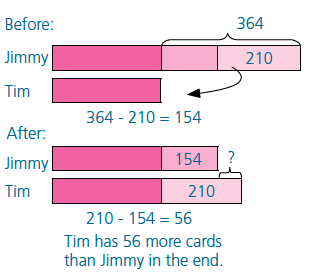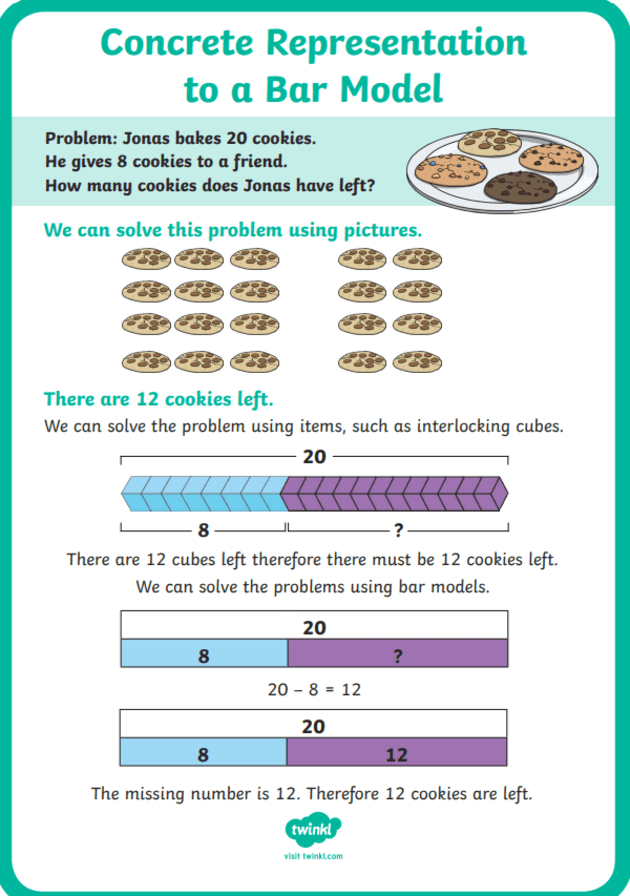Enhance your math lessons using bar model drawing techniques for better comprehension
Wiki Article
Exploring Bar Model Drawing Techniques: A Comprehensive Overview to Imagining Math Concepts
Bar model attracting methods act as a valuable source for both educators and trainees in visualizing mathematical ideas. These models simplify intricate mathematical relationships, assisting in the comprehension of addition, division, subtraction, and multiplication. This overview outlines efficient approaches for applying bar models, promoting energetic engagement and real-world connections. As viewers explore the functional applications and mentor pointers, they will certainly reveal how these methods can transform their approach to mathematics.Recognizing the Essentials of Bar Version Illustration
Bar version drawing serves as a powerful visual device in maths, promoting the understanding of numerical partnerships and analytic strategies. This method involves standing for numbers and their relationships through rectangular bars, making it less complicated to picture procedures such as enhancement, reduction, division, and multiplication. Each bar's size matches to a details worth, permitting students to contrast quantities and understand proportions plainly.To produce a bar version, one begins by identifying the problem's crucial aspects, commonly damaging it down right into parts that can be aesthetically stood for. As an example, in a basic addition problem, 2 bars can be drawn, with their sizes representing the addends. The combined size shows the sum. Additionally, bar versions can be adjusted for extra complicated problems, consisting of portions and ratios, by changing benches appropriately. Understanding these fundamentals lays a strong foundation for reliable analytical and deeper mathematical understanding.
Benefits of Using Bar Designs in Math
Using bar models in maths supplies many benefits that boost knowing and understanding. These visual representations help students in understanding complex principles by breaking them down into convenient parts. Bar designs provide a clear structure for illustrating connections between numbers, making abstract ideas more concrete. They promote a much deeper understanding of mathematical procedures and promote analytic by enabling students to imagine the data they are working with.Furthermore, bar models sustain the advancement of critical believing skills, as students must analyze and interpret the visual details to reason. This technique urges energetic interaction with the material, enhancing retention and proficiency of mathematical principles. By promoting a solid structure in aesthetic literacy, bar designs encourage learners to come close to different mathematical obstacles with self-confidence. Overall, the combination of bar versions right into mathematics education and learning verifies useful in growing both understanding and analytical abilities amongst pupils.
Applying Bar Designs to Addition and Reduction
Bar models act as an effective device for visually standing for addition and subtraction troubles. By highlighting the connection in between numbers, they boost understanding and promote problem-solving. In addition, real-life applications of these versions can help learners understand mathematical concepts in useful contexts.Representing Enhancement Visually
When students encounter enhancement and reduction troubles, visual aids can considerably boost their understanding of these procedures. Bar models work as effective devices for representing addition. By separating a rectangle right into sections that correspond to the numbers entailed, students can visualize the partnership between the amounts. For circumstances, if a pupil requires to include 3 and 5, they can create a bar split right into 2 sections: one area standing for 3 and the other standing for 5. This clear depiction not just simplifies the addition procedure but also reinforces the idea of integrating amounts. As pupils adjust these aesthetic aids, they establish a much deeper comprehension of addition, bring about boosted analytical abilities and better confidence in their mathematical abilities.
Reduction With Bar Versions
Reduction is frequently regarded as a much more intricate operation than addition, bar versions can effectively clarify this process for trainees. By visually representing the amounts included, students can much better comprehend just how numbers associate to one another. In a bar model for subtraction, one bar represents the overall, while one more suggests the quantity being subtracted. This visual distinction aids pupils grasp the concept of "eliminating." If a bar reveals 10 devices, and another bar standing for 4 devices is removed, trainees can conveniently see that 6 devices stay. This method not only fosters understanding of subtraction but likewise help in creating analytic skills, allowing trainees to visualize their mathematical reasoning and boost their overall understanding of mathematical concepts.Real-Life Application Instances
Recognizing reduction through bar models lays a structure for using these techniques in real-life scenarios. In numerous contexts, such as budgeting or shopping, people can imagine just how much cash stays after costs. For instance, if an individual has $50 and spends $20, a bar design can represent the overall amount and the spent part, showing that $30 is left. Furthermore, moms and dads can utilize bar models to aid kids recognize the number of even more items need to be added to finish a set, such as having three apples and requiring 5. This graph streamlines complex problems, promoting understanding and retention. Eventually, bar designs act as effective devices in everyday decision-making, improving mathematical understanding in functional scenarios.Imagining Reproduction and Division With Bar Versions
In discovering the application of bar versions for reproduction and department, it is important to realize their foundational concepts. Creating multiplication models enables learners to picture partnerships between numbers, while efficient department approaches can be illustrated via these aesthetic aids. This approach enhances comprehension and analytical abilities in maths.Recognizing Bar Designs
Bar models act as a powerful aesthetic device for showing the concepts of reproduction and division. They allow Go Here students to represent mathematical partnerships in an organized layout, facilitating a much deeper understanding of these operations. In multiplication, bar models display groups of equal dimension, allowing Going Here individuals to imagine the complete amount when integrating these groups. On the other hand, in division, bar versions assist portray exactly how a total amount is separated into smaller sized, equal parts, making clear the idea of partitioning. By employing these visual help, trainees can grasp the underlying principles of reproduction and division more successfully. This strategy not only boosts understanding yet likewise sustains analytical skills, making bar models an indispensable property in mathematical education.Constructing Reproduction Designs
Creating multiplication designs utilizing bar layouts provides a clear technique for envisioning the process of reproduction. These versions allow students to stand for multiplication as groups of equivalent components, making abstract ideas a lot more concrete. To show (3 times 4), a trainee can draw one bar split right into three equivalent sections, each representing four devices. Additionally, developing a 2nd bar with the same length reinforces the understanding of duplicated addition, as each sector represents one group. This graph not just aids in realizing reproduction however also boosts analytical skills. By utilizing bar models, trainees can much better comprehend connections in between numbers and develop a robust structure for a lot more intricate mathematical principles, resulting in raised self-confidence in their capacities.Visualizing Department Methods

Addressing Word Problems Making Use Of Bar Design Techniques

For instance, in a problem entailing enhancement and subtraction, pupils can attract separate bars for each and every amount and afterwards control them to locate the service. This process not just makes clear the trouble yet also cultivates a deeper conceptual understanding. Bar versions can be adapted for various kinds of word troubles, making them functional throughout different mathematical topics. Inevitably, using bar designs our website can significantly boost trainees' problem-solving skills by offering a clear aesthetic pathway to get to the appropriate response.
Integrating Bar Versions in Different Mathematics Topics
Bar versions can be effortlessly incorporated right into various mathematics topics, boosting pupils' understanding of ideas beyond basic arithmetic. In algebra, these aesthetic tools aid in representing inequalities and equations, making it possible for students to picture connections between variables. When tackling geometry, bar models can illustrate the properties of shapes and spatial reasoning, assisting students realize concepts like area and border properly. In data, bar models promote the interpretation of data collections, permitting pupils to compare amounts and identify patterns visually. In addition, integrating bar models within measurement topics aids in understanding units and conversions by offering a concrete representation of quantities. By using bar models across various mathematical locations, instructors can cultivate a much deeper understanding of complicated concepts, thus enhancing problem-solving skills and promoting essential thinking (bar model drawing techniques). This versatility shows the energy of bar models as a fundamental device for trainees in their mathematical tripTips for Teaching Bar Designs Properly
Incorporating bar designs right into mentor techniques requires thoughtful methods to maximize their performance. Educators needs to start by presenting bar versions with easy, relatable instances that students can quickly grasp. This assists to construct self-confidence and familiarity with the principle. Gradually boosting the complexity of problems enables learners to apply their skills progressively. Additionally, teachers ought to encourage pupils to develop their very own bar designs, advertising energetic involvement and ownership of their discovering.Incorporating joint tasks can also enhance understanding, as students go over and solve problems in teams. Constant feedback is necessary; educators must give constructive discourse on pupils' bar design representations to direct improvement. Ultimately, linking bar versions to real-life circumstances reinforces their significance, helping pupils see the functional applications of their mathematical abilities. By executing these approaches, teachers can effectively harness the power of bar designs in their mathematics instruction.
Regularly Asked Inquiries
Can Bar Versions Be Utilized in Various Other Topics Besides Mathematics?
Bar designs can indeed be utilized in different subjects past mathematics. They effectively highlight ideas in scientific research, social research studies, and language arts, helping to aesthetically represent partnerships, processes, and ideas for enhanced understanding throughout self-controls.What Age Is Best Fit for Learning Bar Versions?
Bar versions are best matched for children ages 7 to 12, as they develop concrete reasoning abilities throughout this duration (bar model drawing techniques). At this age, pupils can effectively understand abstract concepts through aesthetic representation and analytical methodsAre There Digital Devices for Creating Bar Models?

How Can I Analyze Trainee Comprehending of Bar Models?
Reviewing pupil understanding of bar models can involve tests, empirical assessments, and team discussions. Teachers may additionally evaluate trainees' completed designs and their ability to discuss their thinking, making certain a detailed evaluation of understanding.What Are Typical Mistakes When Making Use Of Bar Versions?
Common blunders when making use of bar versions include misstating quantities, failing to accurately identify bars, puzzling addition and subtraction, ignoring to make use of consistent ranges, and neglecting the relevance of clear visual splitting up in between various aspects.In enhancement, bar versions can be adapted for a lot more complicated problems, including proportions and fractions, by adjusting the bars accordingly. Reduction is frequently perceived as a more complex operation than enhancement, bar models can properly clarify this process for students. In a bar model for subtraction, one bar represents the overall, while an additional suggests the quantity being subtracted. If a bar reveals 10 systems, and one more bar standing for 4 devices is eliminated, students can conveniently see that 6 systems remain. When separating a total right into equivalent groups, students can attract a lengthy bar to represent the entire and then sector it right into smaller bars that show each team.
Report this wiki page